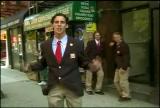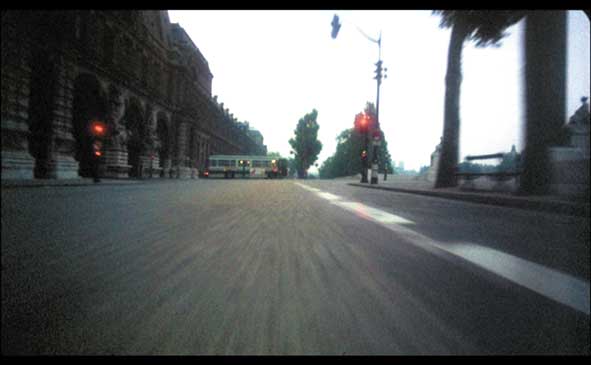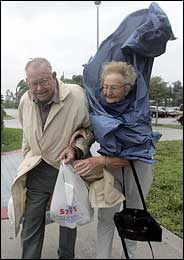Don’t know the editor, but the actors are familiar, and the script, we all know it by heart now (“September 11th, Saddam Hussein, very dangerous, global terrorism”).
BoingBoing points to a video that distills the 4-day message of last month’s Republican National Convention into three or so rhythmic minutes. The award for Most Hysterical goes to New York’s own Rudy Giuliani.
How Do You Run A Convention On A Record Of Failure? [via BoingBoing]
Category: making movies
MPAA: The Tenth Time’s The Charm
And I’m proud to be an American, where at least I know I’m free…to take children to see simulated puppet sex.
Kudos to the MPAA censors–now sitting in their collective bed smoking a Marlboro Light–who made the producers of Team America World Police come ten times
MPAA Fights to Preserve Quality of Puppet Sex
Call it Team ANTI-America, just the kind of devious attack you’d expect in an election year: The ever-patriotic MPAA is bravely taking a stand, seeking to protect the high-quality of simulated puppet sex [SPS] America’s children know and love from cheap Hollywood imitations.
For the last year or so, the Broadway musical, Avenue Q, has been offering Tony Award-winning SPS to Americas children for $95 a ticket. But now, a devious team of low-rent Hollywood types is seeking to flood the SPS market with a poorly articulated product available everywhere–not just on Broadway–for only $9.50, a shocking 90% discount.
The culprit: Trey Parker and Matt Stone’s ironically named Team America World Police, which is due in theaters next week. MPAA censors have been selflessly “studying” Team America‘s simulated puppet oral sex scene–nine times so far–to certify it’s good enough for kids. So far, the movie’s SPS has only received an NC-17.
Note: the MPAA only certifies the quality of SPS; all other puppet simulations are currently unregulated and available on basic cable.
Puppet oral sex goes against grain for US censors [Guardian, LAT, via boingboing]
FS: ‘Mission Accomplished’ Banner, Qty: One (1)
It’s hard to remember now, but things looked so different back then. In August. When Sharon Waxman put David O. Russell on the deck of an aircraft carrier the front page of the Times Arts section for “Conquer[ing] the Hollywood Studio System.” On Aug 16, Russell had turned Warner Bros. into his own personal Ahmed Chalabi, ready to do his bidding:
 Well, that was the plan, anyway. To find out the truth, don’t bother reading the Times, who hasn’t covered the story since; slog instead through the foreign papers and crazy alternative journals like the Los Angeles Times.
Well, that was the plan, anyway. To find out the truth, don’t bother reading the Times, who hasn’t covered the story since; slog instead through the foreign papers and crazy alternative journals like the Los Angeles Times.Here’s a timeline of how, thanks to the foreign insurgents on the ground at Warners, David O. Russell’s grand Iraq strategy went terribly, horribly astray.
Continue reading “FS: ‘Mission Accomplished’ Banner, Qty: One (1)”
As Rumsfeld Is My Co-Producer
David Robb slogged through decades of data–a veritable quagmire of documentation, including production notes, official memos, filmmaker and producer interviews, and screenplay drafts–to write his new book, Operation Hollywood. From the interview he gave to Mother Jones, it sounds like a fascinating story.
That said, the interview gives me an odd feeling that the author–and maybe even Mother Jones herself–might be letting a strong political point of view slip through here and there. Nothing specific, though, maybe it’s just me.
I’m sure Operation Hollywood will become the must-read bible for anyone who decided to get into the motion picture business after seeing Top Gun [one hilarious anecdote from the book: enrollment actually shot up after Top Gun not in film schools, but in the Navy. Who’da thought?].
One wee bit of constructive criticism which I hope arrives in time for the paperback edition: In these perilous times, the book’s subtitle, How the Pentagon Shapes and Censors the Movies, seems needlessly divisive, by which I mean SATANICALLY UNAMERICAN. I suggest it be changed to How Hollywood Does Its Part To Help Keep The Pentagon’s Recruiting and Funding Pipelines Flowing, While Spending Some of That $500 Billion You’re About To Vote For In YOUR District, Congressman.
[via GreenCine]
Mother Jones Intern Intern-views David Robb
Support David Robb, the anti-Military Entertainment Complex, and buy Operation Hollywood: &c., &c. at Amazon.
Watch the Pentagon’s greatest cinematic success, Terrence Malick’s The Thin Red Line on DVD. [What? You say they didn’t do that one??]
More Thanatos, Please
 Speaking of Wong Kar Wai… Eros is a compilation of three great directors’ short films on the subject of, well, eros, love, and sex.
Speaking of Wong Kar Wai… Eros is a compilation of three great directors’ short films on the subject of, well, eros, love, and sex.
Early reports from Toronto say that Wong’s is the only segment that’s right. The others, by Steven Soderbergh and Michelangelo Antonioni, sound like a $5 handjob at the Port Authority and that 15 minutes window before the Spectravision hits your hotel room bill, respectively.
Apparently, the only reason to not leave after WKW’s short is the haunting Caetano Veloso song, “Michelangelo Antonioni,” which bridges the last two films. It’s a wonderful song, to be sure; I’d contemplated using it in the opening scene of my first short, but it was too heavy. I first replaced it with the Pink Floyd bongos from the opening of Antonioni’s Zabriskie Point.
I mention this because of the deep, meaningful connections between Soderbergh’s, Antonioni’s and my own work.
Wong Kar-Wai dominates uneven Eros [Peter Brunette, Indiewire]
According to the Italian producer’s site, the whole thing was producer Stephane Tchal Gadjieff and Antonioni’s trophy wife Enrica’s idea. [Fandango, no, not that Fandango]
RNC Thugz Videomakers Found, Speak
 Mission Accomplished (aka f***newyork, the name of the .mov file) was the hi-larious (so true, though, we’re only laughing on the outside) video of a gang of private school wiggaz telling it like it was about the RNC takeover of the city.
Mission Accomplished (aka f***newyork, the name of the .mov file) was the hi-larious (so true, though, we’re only laughing on the outside) video of a gang of private school wiggaz telling it like it was about the RNC takeover of the city.
While the rest of the world just sat back and laughed at it, the folks at hip hop music tracked down the film’s creators, writer Sam Marks and director Max Rockatansky (aka Matt Lenski) for an interview. It’s great stuff, even if they do use the N-word. And the F-word. And a bunch of other words. A lot.
The Guys Behind the F***NewYork Video [hiphopmusic.com]
Google “f***newyork.mov”, but not with asterisks to find the file.
[via Anil]
Aaron Eckhart IS Samson IN The Grizzly Adams Production OF
The Bible’s Greatest Miracles. Yes, before he donned a wig in Erin Brockovich, but after his breakout performances in Neil Labute’s In The Company of Men and Your Friends and Neighbors (and a supporting role in Oliver Stone’s Any Given Sunday), Aaron Eckhart, sporting a wig that must have required a lot of faith, played an almost Stoppardian Samson in this 1999 made-for-PaxTV documentary.
I remember stopping dead in my channel surfing tracks when I saw my former BYU classmate, New York neighbor and fellow parishioner, and ex-boyfriend of my good friend, doing an Old Testament John Wayne on what looked like the Egyptian set of Dr. Who. My kingdom for a video capture.
But don’t just take my word for the power of this film. Grizzly Adams witnesses best:
History’s most spectacular miracles and claims. . .but are they true? Bible scholars and skeptics examine four of the Bible’s greatest mysteries–David and Goliath; Moses receiving the Ten Commandments on Mt. Sinai; Shadrach, Meshach, and Abednego in the fiery furnace; and the story of strongman Samson and Delilah–to determine if they are myth or reality. Watch dramatic re-creations of Bible events, expert testimony, and conclusive scientific experiments that put these Bible stories to the test. See compelling new evidence that the Bible is indeed factual and trustworthy!
Bonus: the script was written by David Balsiger, who just wow’ed em in Dallas.
Buy The Bible’s Greatest Miracles on DVD, direct from Grizzly Adams Productions, for $19.95.
C’Etait Un Rendezvous: a pure Parisian chase movie

And I thought Ronin had the most jaw-dropping Parisian car chase scene.
In August 1976, French director Claude Lelouch (who, it turns out, did the French segment of 11″09’01, the one where the deaf chick decides to break up with her boyfriend at 9:59 or something) had 9 minutes of film, a Ferrari 275 GTB, a gyro-stabilized camera and mount, and an idea.
He set a route through the center of Paris, from Porte Dauphine, through the Louvre and up to the Basilica of Sacre Coeur, strapped the camera on the bumper, and drove flat out through the (somewhat empty) early morning streets.
Rendezvous is the one-take artifact of that insane and illegal trip. Not technically a chase scene, maybe it should be called a race scene. It’s the verite equivalent of the Hollywood-staged Sunset Blvd race in Against All Odds, and it ranks with the likes of Peter Yates’ Bullitt and Friedkin’s The French Connection for best car chase scenes ever.
With one difference: the obvious danger to bystanders during Rendezvous throws peoples’ moral compasses out of whack. Some, like neonrebel, get all hot for the film, then suddenly turn all critical and judgmental, like a self-hating preacher after scoring a hooker. Others, like a writer for The Daily Express, show amazing lack of judgment when he calls the film “an automotive equivalent of September 11th footage.”
Now you, too, can hate yourself in the morning; after decades underground, C’Etait Un Rendezvous is now available on DVD.
Buy Spirit Level Film’s release of Rendezvous for $28.95 from Chasecam. Read neonrebel’s review. [via the Sachs Report? Why didn’t you tell me about him before?]
[9/17 update: Lelouch has performed another stunt this week, offering free nationwide screenings for his latest film, Les Parisiens, which got panned by critics.]
Bloghdad.com/Gunner_Palace
Tony Scott’s first report from Toronto really gives you a feel for the festival’s sprawl and cinematic frenzy, where you feel like you’re missing movies more than watching them. Meanwhile, he only mentions one film, and he mentions the hell out of it: Gunner Palace, Mike Tucker and Petra Epperlein’s documentary about US soldiers’ lives in Baghad. Here’s a taste:
Gunner Palace is so startling because it suggests – it shows – just how complicated the reality of this war has been. It may not change your mind, but it will certainly deepen your perception and challenge your assumptions, whatever they may be. I hope “Gunner Palace” makes its way quickly from this festival to American theaters, because it is not a movie anyone should miss.
Sure, but did you like it?
Sex, War, and Hype at Toronto Festival of Films [A.O. Scott, NYT]
See a trailer and clips at GunnerPalace.com
Time Lapsing at the WTC Site
Jim Whitaker is the director of a documentary in the making of the changes taking place at the World Trade Center site. Project Rebirth, as it’s called, has been taking time lapse imagery from various cameras perched on buildings surrounding the site since the Spring of 2002, after most debris was cleared away from The Bathtub.
Now, in time for the third anniversary of the attacks, they’ve released a trailer, some time lapse segments, and a webcam. Begun with an imperative to capture History and only a bare conception of what it might actually look like, the filmmakers added street-level and firehouse cameras later on.
Which is interesting, because by definition, human presence, the individual, is rendered invisible in a multi-year time lapse. Like Hiroshi Sugimoto’s movie screen photographs, which are exposed for the duration of a film. Technically, the resulting image “contains” all the information in the film, but the screen itself is pure white. Meanwhile, the minutest details of the theaters–architecture, seats, stages, curtains–emerge from the darkness only because of the projected film.
projectrebirth.org
Ground Zero, The Long View [Sarah Boxer, NYT]
Time Lapsing at the WTC Site
Jim Whitaker is the director of a documentary in the making of the changes taking place at the World Trade Center site. Project Rebirth, as it’s called, has been taking time lapse imagery from various cameras perched on buildings surrounding the site since the Spring of 2002, after most debris was cleared away from The Bathtub.
Now, in time for the third anniversary of the attacks, they’ve released a trailer, some time lapse segments, and a webcam. Begun with an imperative to capture History and only a bare conception of what it might actually look like, the filmmakers added street-level and firehouse cameras later on.
Which is interesting, because by definition, human presence, the individual, is rendered invisible in a multi-year time lapse. Like Hiroshi Sugimoto’s movie screen photographs, which are exposed for the duration of a film. Technically, the resulting image “contains” all the information in the film, but the screen itself is pure white. Meanwhile, the minutest details of the theaters–architecture, seats, stages, curtains–emerge from the darkness only because of the projected film.
projectrebirth.org
Ground Zero, The Long View [Sarah Boxer, NYT]
Like Watching Wallpaper Dry
Wallpaper* founding editor Tyler Brule will host and produce The Desk, BBC4’s “long awaited media show,” a media-gazing TV gig even more prestigious than, say, Topic A with Tina Brown.
Brule’s strategy for getting the slot may give a hint of what to come; according to the Guardian, Brule first had to beat off some stiff challengers, and “he also beat off other more experienced media experts including Loaded founder James Wheeler, author Paul Morley and Newsnight’s Kirsty Wark.”
Apparently, so many people wanted to try their hand at the low-paying job because it’s been a stepping stone for careers in television. I was going to try to squeeze a couple more jokes out of this, but I think I’ll stop here.
Wallpaper man wraps up BBC media role [Media Guardian, via mediabistro]
It takes a village planner, Brule’s imaginary neighborhood shop-a-thon for NYT’s T
Like Watching Wallpaper Dry
Wallpaper* founding editor Tyler Brule will host and produce The Desk, BBC4’s “long awaited media show,” a media-gazing TV gig even more prestigious than, say, Topic A with Tina Brown.
Brule’s strategy for getting the slot may give a hint of what to come; according to the Guardian, Brule first had to beat off some stiff challengers, and “he also beat off other more experienced media experts including Loaded founder James Wheeler, author Paul Morley and Newsnight’s Kirsty Wark.”
Apparently, so many people wanted to try their hand at the low-paying job because it’s been a stepping stone for careers in television. I was going to try to squeeze a couple more jokes out of this, but I think I’ll stop here.
Wallpaper man wraps up BBC media role [Media Guardian, via mediabistro]
It takes a village planner, Brule’s imaginary neighborhood shop-a-thon for NYT’s T
The Woman in the Hefty Bag Speaks
 “We are starting to go buggy, just getting on one another’s nerves,” Mrs Mildred Mauney, 81, told The New York Times, after spending the night with some strangers in a classroom-turned-shelter in Palm Beach Gardens, Florida.
“We are starting to go buggy, just getting on one another’s nerves,” Mrs Mildred Mauney, 81, told The New York Times, after spending the night with some strangers in a classroom-turned-shelter in Palm Beach Gardens, Florida.
Whatever, Millie. Join the club. Mrs. Mauney’s must-have accessory for evacuating their mobile home, an inflated trash bag, reminded me of a Bill Cunningham snap of hard-core fashion muse Isabella Blow that was used to illustrate a NYT street photography story in 2002.
I can’t believe that just two years ago, I would’ve mused so hard on Walter Benjamin, Jean Paul Gaultier, “accidental” street photography, and documentary film staging.
“Well, you have to be a nut, kid.” [greg.org, oct. 2002]
